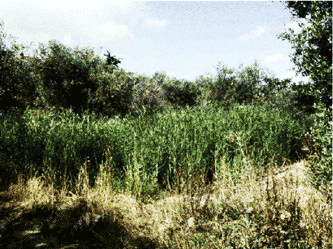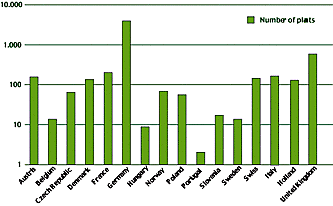Constructed wetlands, natural water purification systems
Presentation

Horizontal subsurface flow system serving an agro-tourism facility (Florence, Italy)
Any water purification process seeks to lower the level of contaminants present in the water by means of biological agents. The process occurs spontaneously in all natural hydro systems and guarantees their “self-purifying” capacity.
The Constructed Wetlands natural water purification systems take advantage of a process that occurs spontaneously in nature, optimizing the biological processes to provide higher purification levels.
These systems were applied for the first time in Germany in 1952 following a series of experiments conducted by the Max Planck Institute. Subsequently several European countries (France, England, Austria, Denmark, Italy, Holland, Switzerland) activated specific research programmes and after extensive scientific comparisons the European Guidelines were drawn up.
The obvious economic advantages low operating costs and reduced energy consumption and the optimal purification levels have led some countries to adopt the system on a broad scale, above all for small and medium-sized applications, but also for purifying waste water from technological systems. In the latter case the treated water may be reused in agriculture, industry and for non-drinking purposes generally. Reusing appropriately purified waste water contributes to a notable reduction in the wasteful use of high quality (drinkable) water, which is an increasingly costly resource.
A further factor in favour of the Constructed Wetland systems is their complete blending in with the environment (see photo over). In recent years the European Community has given priority to financing these systems over more conventional high-technology systems.
In addition, the use of Constructed Wetlands systems allows for purification choices that are decentralised and ad hoc for a given area and for specific environmental situations. Avoiding centralisation and large systems helps provide for greater protection of the hydro-geological balance.
The systems are particularly well-adapted for resolving water purification problems in rural and hilly areas where collecting waters in a centralised system would involve high costs and negative environmental impact.
In marginal and degraded areas the use of these systems can provide an opportunity to restore the environment.
The application of natural systems allows for resolving the hygienic-sanitary problems of waste while making more frugal use of water.
There are many types of Constructed Wetlands systems, but the ones most widely applied in the European context are the following:
• Horizontal Subsurface Flow Systems (SFS-h)
• Vertical Subsurface Flow Systems (SFS-v)
• Surface Flow Systems (FWS)
These system types may be used singly or in combinations in systems called “multi-stage”.
Each type is constructed differently and provides purification levels particular to the kind of contaminant to be removed.
This allows for appropriate treatment in each individual case, while a combination of the systems makes it possible to treat even wastes that differ markedly from one another. For example, an isolated house in a rural setting or a small-scale private consumer could use the simplest type, a horizontal subsurface flow system, while a cheese factory or animal farm would require a combined system where the different types are selected according to the purification objectives and the quantitative and qualitative characteristics of the waste.
In Europe at present there are about 11,370 officially-registered Constructed Wetlands systems monitored by research institutes.
DOWNLOAD THE BROCHURE PDF
english (1.0 MB)spanish (0.7 MB)
albanian (0.4 MB)








 COUNTRY OF ORIGIN
COUNTRY OF ORIGIN OUTSTANDING IDEASS PROJECTS
OUTSTANDING IDEASS PROJECTS